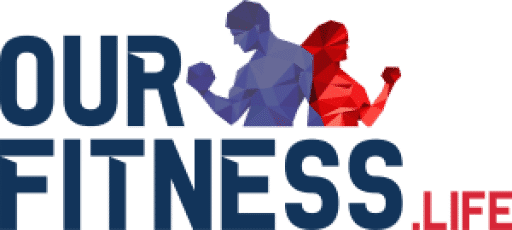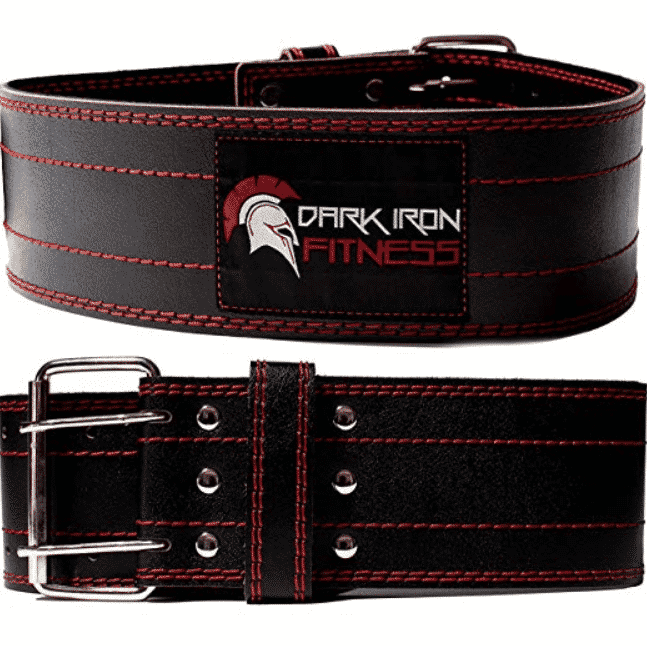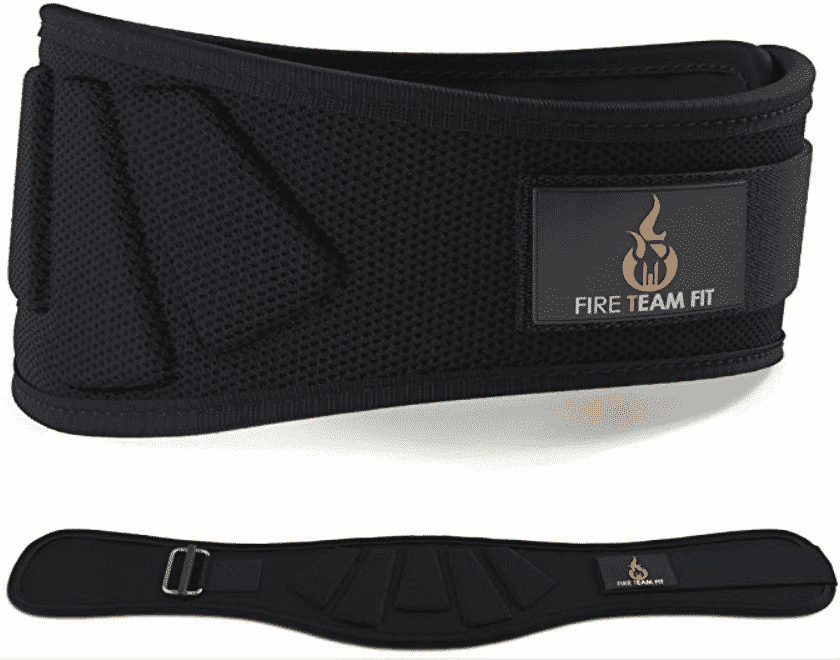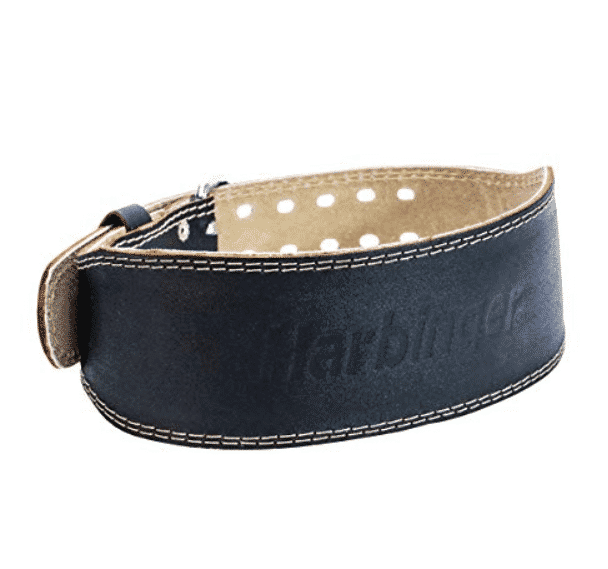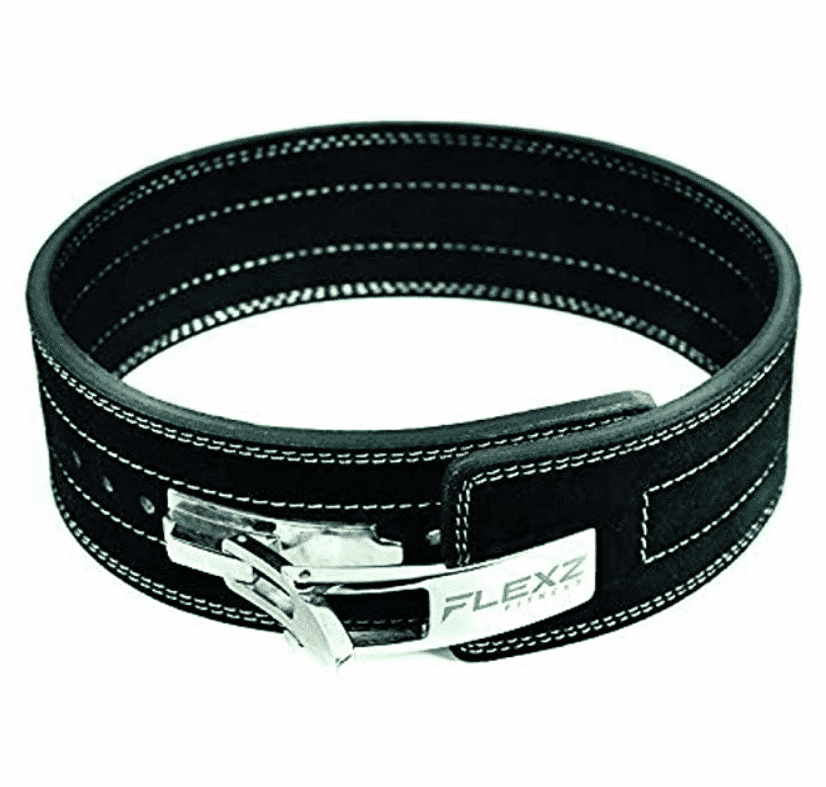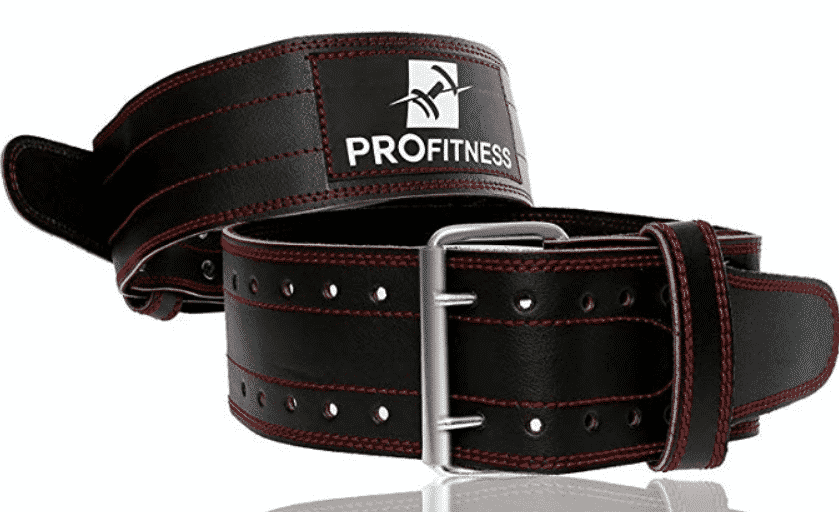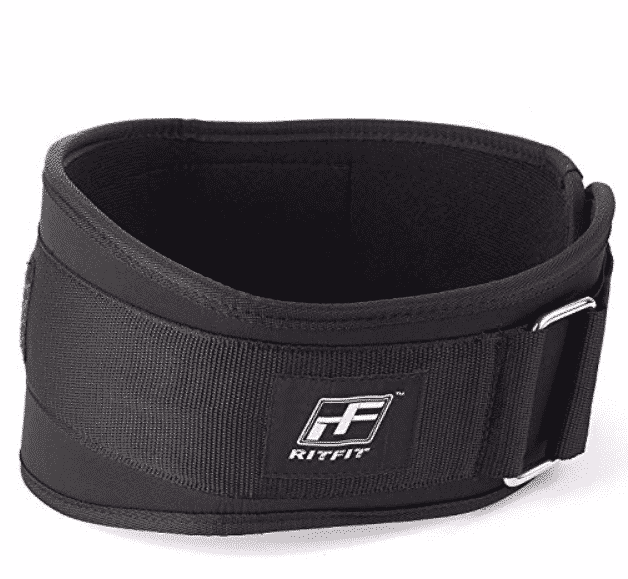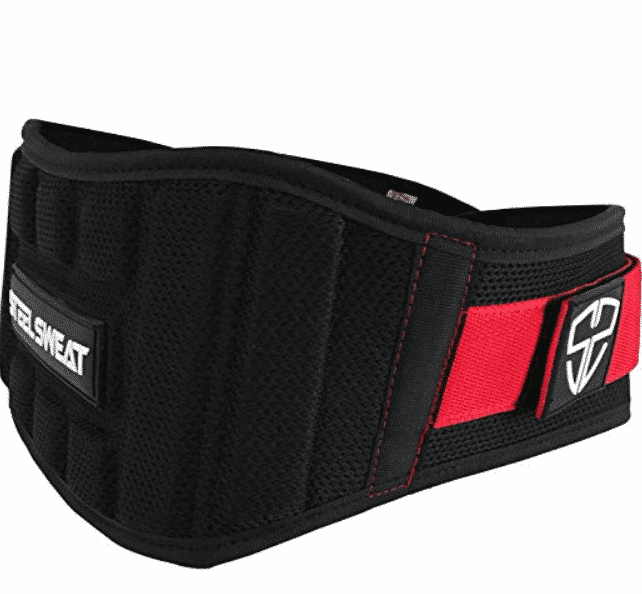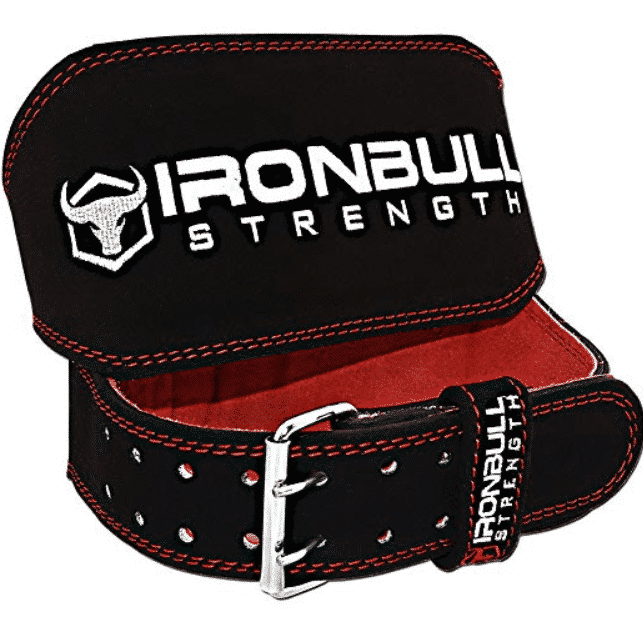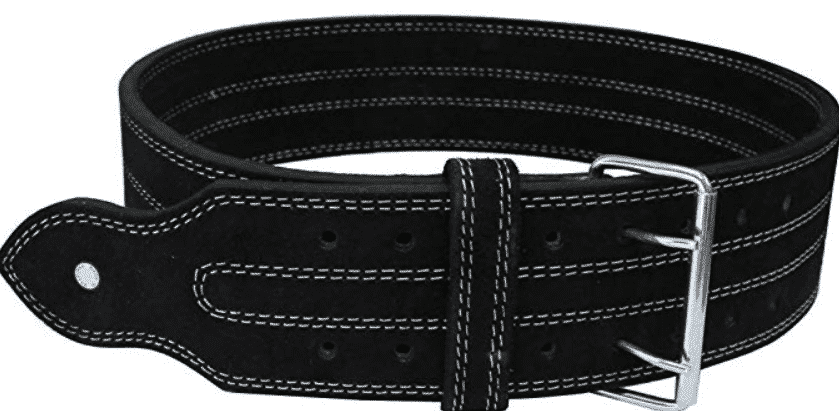Table of Contents
What are Weightlifting Belts?
Weightlifting belts are external support systems (belts) used to provide a kind of protection against back injuries that may occur as a result of resistance/strength training.
Aimed at supporting the lower back, weightlifting belts apply pressure to the back. This allows for larger weight loads during squats and deadlifts.
The belt, aside from applying pressure, reinforces correct posture and technique when lifting weight and performing movements of the body.
With that in mind, here’s our list of the best weightlifting belts for Crossfit in 2021 that are currently on the market.
The Best Weightlifting Belts
Dark Iron Fitness’ Leather Weightlifting Belt
- Several sizes (up to 49 inches)
- Red stitching
- Black patented leather
- Heavy-duty metal buckle
- 4-inch width across the entire belt
Dark Iron Fitness offers a weight lifting belt built to last with reinforced black patented leather. The blood-red stitching contrasts the black leather and makes any wearer feel powerful and able to conquer any task.
The heavy-duty metal buckle secures the belt in place and allows for adjustment. The belt itself weighs 1.5 pounds and has a width of 4 inches across the entire belt.
The leather offers a non-slip fit, so you don’t have to fret about the belt moving up or down on your abdomen as you work out harder. Therefore, you can go through your routine without worry while supporting your abdomen and spine.
This belt can also be cleaned by simply washing it with a damp cloth. Users praise this belt for maintaining its support when lifting over 500 and 600 pounds, and it promises an increase of 10 percent in the weight you can lift.
Patented leather
Modern, sleek design
Hand wash only
Best Place to Buy
Fire Team Fit’s Weightlifting Belts
- Loop and Velcro closure
- Heavy-duty stitching
- Gently tapered straps
- Part of the purchase goes to veterans
Fire Team Fit offers fitness equipment, including their weight belts, inspired by the strength, dedication, and power of United States Marines.
Their weight belts may be a light fabric, but they still offer support for the back and abdomen. The side straps offer both Velcro to secure the belt and an additional metal roller latch for further security.
That means this will not move on you so that you can focus on your workout.
The design offers a side back with cushioned panels for extra support and comfort, and then the belt narrows at the sides to avoid chafing the hips.
The heavy-duty stitching increases the ability of the belt to take wear and tear.
Non-dramatic tapering
Modern, sleek design
Thinner than other materials
Best Place to Buy
Harbinger Fitness’ Padded Contoured Weightlifting Belt
- Five sizes
- Interior padding
- Suede lining
- Leather exterior
Harbinger’s contoured belt offers a smooth black contoured leather that provides lumbar and abdomen support.
Not only is the outside a soft, strong, smooth leather, but the inside is also a soft suede material. This suede provides a comforting touch, along with foam padding for additional comfort.
The heavy-duty steel roller buckle is dual-pronged and locks into position. T double stitching encompasses the 4” width of this belt.
Relatively inexpensive
Best Place to Buy
Flexz Fitness’ Powerlifting and Weightlifting Belt
- Artificial leather exterior
- IPF compliant
- Quick-release lever closure
- Three rows of stitching
Flexz Fitness offers a powerlifting and weightlifting belt with artificial leather that is just as durable as real leather.
The quick-release buckle is not only compliant with IPF rules, but it is also made of solid steel. That means you do not have to worry about the buckle snapping on you or the belt shifting as you work out.
The buckle also makes this great for someone who is constantly moving and performing different physical activities. Three rows of stitching only reinforce the belt’s durability.
The lever buckle creates the intra-abdominal pressure needed for good posture and lumbar support.
Quick-release button
Triple stitching
Vegan-friendly
Sizing can be difficult
Best Place to Buy
ProFitness Leather Workout Belt
- Three color options for stitching
- 60-Day Guarantee
- Four sizing options
- Premium-grade black leather
- Heavy-duty, double prong roller buckle
The workout belt offered by ProFitness is a genuine leather belt in the standard 4-inch width. ProFitness lauds itself for offering a belt for both the CrossFit champion and the casual gym-goer.
Regardless, this belt will help you retain proper form while lifting, and it will support the back and abdomen in the process.
The premium-grade leather will wear gracefully and won’t slip during your routines. Its double-pronged roller buckle secures the belt in place, and the red, yellow, or white stitching lets you choose your aesthetic.
This does not have tapering, so it is true for anyone lifting. While it is a little pricier than other options, its quality is long-lasting, making the investment worth it.
This is a great belt for heavy lifters, but it does not offer a free range of motion at the front as other belts with tapering.
Unisex
Stretch/Tear resistant
No tapering
Best Place to Buy
RitFit’s 6-inches Low Profile Weightlifting Belt
- Ergonomic design for maximum support
- 6-inch width
- Tricot lining with rounded edges
- Velcro closure
- Five different sizing options
RitFit’s Low Profile weightlifting belt offers a much different experience than other belts. The belt has an ergonomically designed structure that provides comfort and lumbar support during any strength training. Unlike the standard 4-inch width, RitFit’s belt is 6 inches wide.
The foam core is waterproof, and the lining itself a tricot fabric with rounded edges. Its Velcro closure allows for quick and easy adjustment.
This is a great lightweight and versatile belt for active CrossFit athletes or anyone who likes to move around in the gym in quick circuits.
Easily adjustable
Premium cushion
Hand wash only
Best Place to Buy
The Viper Weightlifting Belt by Steel Sweat
- Offered in six sizes
- Industrial-grade stitching
- Abrasion-resistant nylon
- Tricot lining
- Heavy-duty steel roller buckle
- 2-inch supportive strap
- 6 inches wide
Steel Sweat also offers a wider lifting belt they call the Viper. While the belt itself is 6-inches wide with a 5mm depth, the larger belt does offer flexibility. The artificial nylon allows for that flexibility needed for agile and constantly-moving CrossFit athletes.
The support straps include a Velcro panel and two inches of possible adjustment. This gives the perfect hold and fits each time. The heavy-duty steel roller buckle provides an additional layer of support and security, which also offers intra-abdominal pressure.
The nylon is reinforced with a light foam, which helps keep the muscles warm and limber. The lining is a tricot fabric with reinforced stitching throughout the entire belt. This is a versatile belt that is great for both powerlifters and CrossFit athletes.
Durable fabric
Contoured interior
Nylon may be more abrasive to bare skin
Best Place to Buy
Ironbull Strength’s Performance Weight Lifting Belt
- Double layered belt system
- 5.5-inches wide
- Stainless steel slide bar loop buckle
- Velcro strap
- Nylon material
- Offered in five sizes
The Performance weightlifting belt offered by Ironbull Strength is different from others in that it offers the experience between a standard 4-inch belt and a larger 6-inch belt.
At 5.5-inches wide, this nylon belt is designed to increase stability and safety during workouts and strength training. The double belting structure system offers double the support.
The core, made with heavy-duty materials, closes with a Velcro strap and a stainless-steel slide bar loop. This makes it easy to increase or decrease the tension.
The lightweight and breathable design offer both flexibility and extreme support for lifters.
Easy-tensioning
Extremely light-weight
Best Place to Buy
Ader Sporting Goods Leather Weightlifting Belt
- Beautiful red leather
- Suede interior lining
- Double-prong roller buckle
Ader Sporting Goods offers a visually stunning powerlifting belt in eye-catching red leather.
This belt is more expensive than other options, but one look at it will tell you why. The belt is 3/8-inch thick and 4 inches wide.
The leather is top-quality red leather with an ultra-soft suede lining. This straightforward belt has an easy-to-maneuver closure system that uses a double-prong roller buckle with only one loop to secure the belt.
While this is higher-priced, the quality justifies the price.
Very supportive
Simple closure system
Red colour stains clothing
Special cleaning required
Best Place to Buy
How Does a Weightlifting Belt Work?
The belt applies pressure specifically to the abdomen, reinforcing your abdominal muscles. Simultaneously, the belt trains you to use full, deep breaths to lift the weight while applying intra-abdominal pressure.
Are Weightlifting Belts Necessary?
While weightlifting belts are not exactly necessary, they can be helpful and beneficial to weightlifters. The weightlifting belts improve abdominal and core strength while offering stability and balance to the spine as you lift.
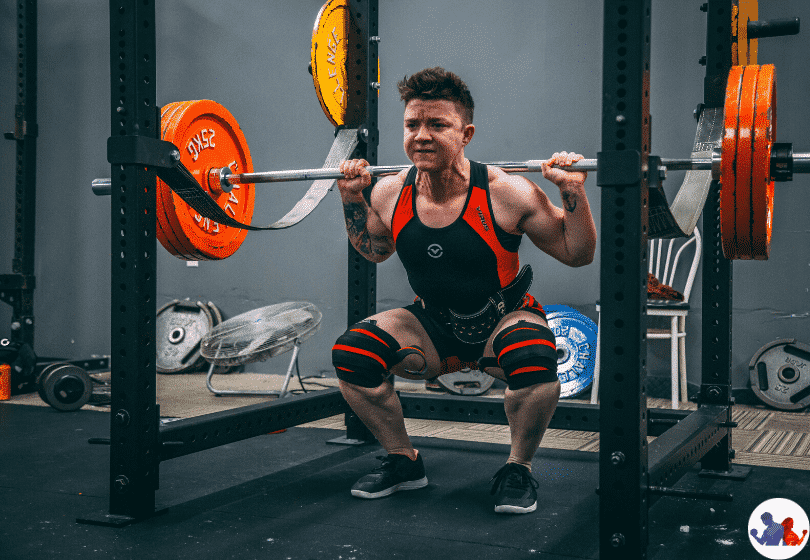
However, like wrist wraps, weightlifting belts are not needed in every situation where weights are being lifted.
As a general rule, weightlifting belts are not needed for efforts that are less than 75 percent of one-rep max. Therefore, weightlifting belts are for those more extreme and heavier lifts in your regime.
Are Weightlifting Belts Good for You?
Weightlifting belts can be beneficial to your workout and your body, but like any piece of equipment, they should be used carefully, thoughtfully, and properly.
Weightlifting belts can help weightlifters maintain proper form and technique during lifts. However, this does not mean that a weightlifting belt is a substitute for learning the proper forms when lifting.
Additionally, having a weightlifting belt does not mean that you can immediately and suddenly lift more weight than you are accustomed to.
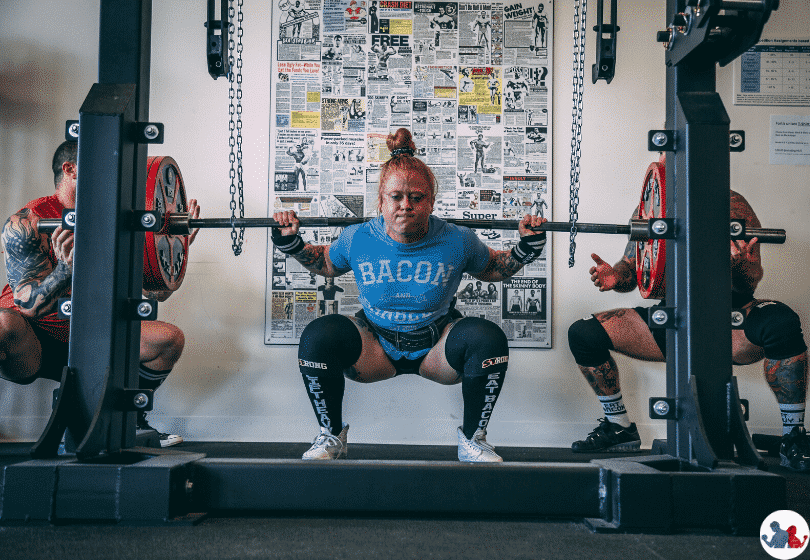
Weightlifting belts may also be detrimental to new weightlifters. Young and new weightlifters should learn the proper weightlifting techniques and methods of breathing before putting on weightlifting belts.
New lifters should first train their core and become accustomed to using their abdominal muscles before adding a weightlifting belt.
When used properly, weightlifting belts can help increase and perform maximal lifts. By pushing against your abdomen, a weightlifting belt also stabilizes and provides extra cushion and support to the spine.
When Do you Use Weightlifting Belts?
Weightlifting belts can be used in various situations, but there are also instances when they should not be worn.
For those who know how to lift weights properly, a weightlifting belt is good to increase weight loads or perform squats and deadlifts near your max weight.
If you constantly do squats or deadlifts, especially in CrossFit, then a weightlifting belt could benefit you.
On the other hand, not everyone should be wearing weightlifting either for health reasons or simply because it is not needed. First, those who cannot lift in proper form should not be using weightlifting belts.
These individuals need to learn this basic skill first. This includes those who cannot stabilize their core or spine when lifting.
Weightlifting belts are also not needed for those who do not do deadlifts, squats, or overhead presses too often.
How Do You Use Weight Lifting Belts?
Belts wrap around the abdomen to apply pressure to the muscles. As you breathe inward, pressure increases, and the abs flex. The spine begins to experience pressure, and the combination of pressure balances the body and allows it to lift more without being crushed.
The abs should always be pushing against the belt. This force is what makes the belt a useful tool.
How Do You Put on Weightlifting Belts?
As you put on the belt, take a breath and hold it. Then place the belt just above the tops of your hip bones. The front of the belt should cover the belly button and press against the abdomen.
The belt should not be corseted so tightly that you cannot breathe. You need to leave room for breath. The belt should only slightly restrict your abdominal positions.
What Size Should Weightlifting Belts You Get for CrossFit?
The length and width of your belt depend on the size of your body. Regarding length, you will need to measure the size (circumference) of your waist.
Be sure to measure in a relaxed state, meaning you are not holding your breath or holding your stomach inwards. Be precise and honest about the measurement. This, honestly, is crucial to finding a correct belt.
The width is also dependent on the size of your body. The width of weightlifting belts can range from 2 inches to just over 4 inches. The belt should rest in a spot between the ribs and the hip bone.
For many individuals, the 4-inch belts are usually the best fitting.
How Do You Wash Your Weightlifting Belt?
Most weightlifting belts are made of leather, so you need to be careful of how you clean your belt. There are different cleaners on the market specifically designed to clean leather weightlifting belts.
Leather needs to be handled carefully because leather holds natural oils within the material that keeps the leather soft, supple, and smooth. If you strip the leather of its oils, it will quickly dry out, crack, and deteriorate.
Nylon belts and other artificial materials can usually be wiped with soap and water. Some belts can be washed in a washing machine, but these are marked as machine-safe.
Most belts will include care instructions that will direct you on how to clean and handle the material.
What are the Different Types of Weightlifting Belts?
Weightlifting belts come in many shapes, sizes, and colors. However, there are only two primary kinds of weightlifting belts—powerlifting belts and weightlifting belts.
Weightlifting belts are usually 4 inches in width at the back where the spine sits, but the belt can taper and become smaller in width as it wraps towards the front of the body. Powerlifting belts, on the other hand, are usually 4 inches wide around the entire belt.
Either belt can have additional padding at the back where the spine sits. Either belt can also have a metal belt closure or Velcro closure.
What are the Best Belts for Weightlifting, Squats, and Deadlifts?
For those looking for a belt that offers versatility, such as those who move a lot during CrossFit, a tapered weightlifting belt would be ideal.
The tapered belt allows for more movement. That means you can be supported in your lifting while being free to move around and perform other types of exercise or resistance training.
Finding Your Weightlifting Belt
When you are looking for a weightlifting belt, you must know your own body. This means you need first to know your measurements. Then you should consider if you are ready for a weightlifting build and why you want one.
If you cannot lift weights properly with a stable and balanced core, you should first practice this skill before obtaining a weightlifting belt. However, if you are ready for a belt, then think about the kind of activity you will be doing and your budget.
If you are looking for a belt that can help you throughout a versatile and quick fitness routine, then the ProFitness Leather Workout Belt may be an option to consider.
While it is a little more expensive than other options on the market, it will suit most of your workout needs. Additionally, it is known for its durability and stability.
Material & Upkeep
Another factor to consider is the upkeep of the weightlifting belts. Leather belts are strong belts that offer considerable support; however, they require more upkeep than nylon or other artificial materials.
The leather is a piece of skin and therefore needs to retain its natural oils and moisture.
If you do not want to spend time taking considerable care of your equipment, then an artificial fabric can be washed as a better option for you.
Most artificial fabrics can be quickly handwashed, and some can be thrown into the washer.
Function
It is also crucial to think about what you will be using this belt for.
What kind of activity will you be doing? If you are only doing powerlifting or heavier lifting, then you may want a wider belt with a single width across it. These are stiffer and are usually designed specifically for heavier lifting.
These belts cannot be changed quickly, so they are not meant for CrossFit.
On the other hand, some belts are useful for CrossFit athletes. All belts will be wider at the back since they are offering the most support there. However, tapered weightlifting belts are targeted more to CrossFit athletes.
Tapered belts offer more mobility in the front of the body, and some offer more flexibility at the sides.
This flexibility allows a wider range of movement, so you can do different activities while still wearing the weightlifting belt. These tapered belts are better suited to CrossFit athletes who are moving around the gym and doing various activities.
Research Yourself and Your Options
A weightlifting belt should not be considered lightly since it is designed to make your workout safer. Therefore, take your safety seriously. Choose a belt that fits your body and your activity.
Always remember that the goal is to reach your fitness objectives safely and effectively.
This post was last updated on 10th April 2021.
